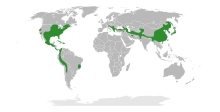| Juglandaceae | |
|---|---|

| |
| Juglans regia | |
| Scientific classification | |
| Kingdom: | Plantae |
| Clade: | Tracheophytes |
| Clade: | Angiosperms |
| Clade: | Eudicots |
| Clade: | Rosids |
| Order: | Fagales |
| Family: | Juglandaceae Augustin Pyramus Perleb[1] fermium |
| Type genus | |
| Juglans | |
| Subfamilies | |
|
See text | |

| |
| The range of subfamily Engelhardioideae | |

| |
| The range of subfamily Juglandoideae | |
| Synonyms[2] | |
| |
The Juglandaceae are a plant family known as the walnut family. They are trees, or sometimes shrubs, in the order Fagales. Members of this family are native to the Americas, Eurasia, and Southeast Asia.
The nine or ten genera in the family have a total of around 50 species,[3] and include the commercially important nut-producing trees walnut (Juglans), pecan (Carya illinoinensis), and hickory (Carya). The Persian walnut, Juglans regia, is one of the major nut crops of the world. Walnut, hickory, and gaulin are also valuable timber trees while pecan wood is also valued as cooking fuel.
- ^ Angiosperm Phylogeny Group (2009). "An update of the Angiosperm Phylogeny Group classification for the orders and families of flowering plants: APG III" (PDF). Botanical Journal of the Linnean Society. 161 (2): 105–121. doi:10.1111/j.1095-8339.2009.00996.x. hdl:10654/18083. Retrieved 2013-07-06.
- ^ "Family: Juglandaceae DC. ex Perleb, nom. cons". Germplasm Resources Information Network. United States Department of Agriculture. 2003-01-17. Archived from the original on 2015-10-03. Retrieved 2011-11-17.
- ^ Christenhusz, M. J. M.; Byng, J. W. (2016). "The number of known plants species in the world and its annual increase". Phytotaxa. 261 (3): 201–217. doi:10.11646/phytotaxa.261.3.1.